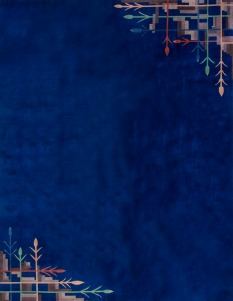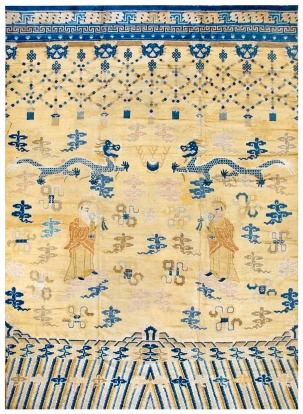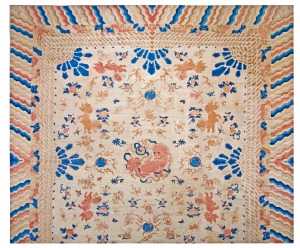The term Art Deco refers to the style launched at the 1925 Paris World’s Fair Exhibition of Modern and Industrial Decorative Art. Woven between the wars for the Western Market by mostly American owned firms, especially Nichols and Fette, Chinese Art Deco rugs (as the name implies) were made in thick heavy weaves using strong colors, assymetric patterns, and downplaying the Chinese-ness of the carpet.



 Nichols rugs are more strong toned than the pastel Fette. In 1924 W. A. B. Nichols introduced the now world renowned “Super Chinese Rug”. These rugs were known in most markets as the most durable and beautiful product of the modern Chinese weavers art. The reason that Nichols Super Rugs may have been so unique to themselves, is that every last part of the process was done by Nichols Company, in house. Most were woven in the coastal port city of Tiensin, though other lesser known workshops were also active.
Nichols rugs are more strong toned than the pastel Fette. In 1924 W. A. B. Nichols introduced the now world renowned “Super Chinese Rug”. These rugs were known in most markets as the most durable and beautiful product of the modern Chinese weavers art. The reason that Nichols Super Rugs may have been so unique to themselves, is that every last part of the process was done by Nichols Company, in house. Most were woven in the coastal port city of Tiensin, though other lesser known workshops were also active.

Helen Fette initially went to China as a missionary, selling small rugs to raise funds for various charities. Teaming up with Chinese rug manufacturer Li Meng Shu to form the Fette-Li Company, the pair started producing rugs out of the Peking area in the early 1920s, becoming one of the largest exporters of the period. Fette rugs usually have a floppy feel because the cotton warps are thinner and more pliable than those used in Nichols carpets, resulting in a soft, limber feel. Many of the designs, over viewed by Fette, were taken from Chinese emroidery, or inspired by traditional Chinese motifs.
Both Fette and Nichols companies used fabric tags on the back of their rugs for identification purposes. Nichols also stamped “handwoven in China by Nichols” onto the backside of the fringe, however if the fringe has worn or been repaired, the mark will be absent. Because Fette and Nichols were so closely associated with the Deco period, rugs woven in their trademark style, without any identifying marks, are routinely referred to as Fette or Nichols style.


Some pieces are ultra-geometric and haute-Deco moderne in character: these are very rare.



More frequent are pieces with bits of Chinese ornament: vases or other precious objects, paeonies, vines, fences, etc.



Most common is the 9’0″ x 12’0″ size, in colors never found in mainstream Chinese rugs: backgrounds in black, mauve, purple, hot pink, orange, olive, employing the best synthetic chrome dyes of the period. Prices are still reasonable and carpets in top condition are available.
to view these rugs on our website, please use the following links:
http://www.rahmanan.com/inventory/show/21017/
http://www.rahmanan.com/inventory/show/19573/
http://www.rahmanan.com/inventory/show/19778/
http://www.rahmanan.com/inventory/show/20278/
http://www.rahmanan.com/inventory/show/40-986/
http://www.rahmanan.com/inventory/show/18310/
http://www.rahmanan.com/inventory/show/20997/
http://www.rahmanan.com/inventory/show/20756/
http://www.rahmanan.com/inventory/show/20300/
http://www.rahmanan.com/inventory/show/19482/
http://www.rahmanan.com/inventory/show/20446/
*research and writing by Peter Saunders & Katrina Mauro


















































